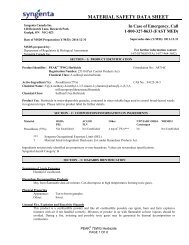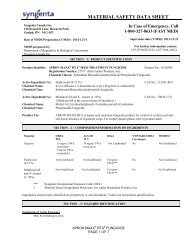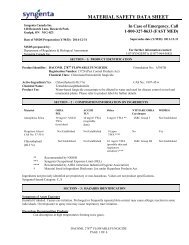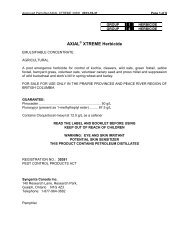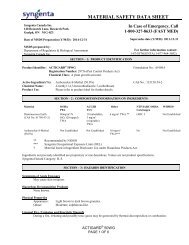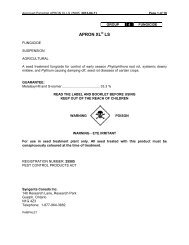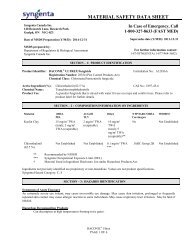Scimitar MSDS - Syngenta Farm
Scimitar MSDS - Syngenta Farm
Scimitar MSDS - Syngenta Farm
Create successful ePaper yourself
Turn your PDF publications into a flip-book with our unique Google optimized e-Paper software.
MATERIAL SAFETY DATA SHEET<strong>Syngenta</strong> Crop Protection Canada, Inc.140 Research Lane, Research ParkGuelph, ON N1G 4Z3Date of <strong>MSDS</strong> Preparation (Y/M/D): 2008-12-31In Case of Emergency, Call1-800-327-8633 (FAST MED)Supersedes date (Y/M/D): 2005-12-31<strong>MSDS</strong> prepared by:Department of Regulatory & Biology Development<strong>Syngenta</strong> Crop Protection Canada, IncSECTION – 1: PRODUCT IDENTIFICATIONFor further information contact:1-87-SYNGENTA (1-877-964-3682)Product Identifier: SCIMITAR ® CS InsecticideRegistration Number: 28499 (Pest Control Products Act)Chemical Class: Synthetic pyrethroidFormulation No.: A12690AActive Ingredient (%): Lambda-Cyhalothrin Technical (9.7 %) CAS No.: 91465-08-6Chemical Name: [1a(S*),3a(Z)]-cyano(3-phenoxyphenyl)methyl-3-(2-chloro-3,3,3-trifluoro-1-propenyl)-2,2-dimethylcyclopropanecarboxylateProduct Use:For control of insects on labelled crops. For further details please refer to product label.SECTION – 2 : COMPOSITION/INFORMATION ON INGREDIENTSMaterialOSHAPELACGIHTLVOtherPetroleum Solvent Not Established Not Established 100 mg/m 3(15 ppm) TWA*NTP/IARC/OSHACarcinogenNoWHMIS†Not Established1,2,4 TrimethylbenzeneCAS No. 95-63-6( 2.2 %)Not Established 25 ppm TWA 25 ppm TWA** No YesCumene (< 1 %)50 ppm TWA(Dermal)50 ppm TWA Not Established No Not EstablishedPropylene GlycolCAS No. 57-55-6Not Established Not Established 50 ppm TWA**** No YesXylene ( 1 %)CAS No. 1330-20-7100 ppm TWA 100 ppm TWA;150 ppm STEL100 ppm TWA** IARC Group 3 Not EstablishedLambda-CyhalothrinTechnical(9.7 %)Not Established Not Established 0.04 mg/m 3 TWA(Dermal)**** Recommended by manufacturer** Recommended by NIOSH*** <strong>Syngenta</strong> Occupational Exposure Limit (OEL)**** Recommended by AIHA (American Industrial Hygiene Association)† Material listed in Ingredient Disclosure List under Hazardous Products Act.NoNot EstablishedIngredients not precisely identified are proprietary or non-hazardous. Values are not product specifications.SECTION – 3: HAZARDS IDENTIFICATIONSymptoms of Acute ExposureMay cause eye and skin irritation. Allergic skin reactions are possible. Exposure to high vapour levels may causeSCIMITAR ® CS InsecticidePAGE 1 OF 7
headaches, drowsiness or dizziness. May cause temporary itching, tingling, burning or numbness of exposed skin,called paresthesia.Hazardous Decomposition ProductsCan decompose at high temperatures and form toxic gases.Physical PropertiesAppearance:Odour:Off-white liquid.Slight odour/typical aromatic solvent.Unusual Fire, Explosion and Reactivity HazardsDuring a fire, irritating and possibly toxic gases may be generated by thermal decomposition or combustion.Potential Health EffectsRelevant routes of exposure:Skin, eyes, mouth, lungs.Adverse health effects from exposure to product or ingredients of product:GENERAL INFORMATION:Pyrethroids may produce non-specific symptoms such as nausea, vomiting, abdominal pain and diarrhea. Largedoses may cause disturbance of the nervous system with tremors, ataxia, weakness of limbs, convulsions, coma,and death from respiratory depression. Dermal contact with pyrethroids in the facial area may cause a subjectivesensation of tingling or numbness (paresthesia). There is no evidence of any long-term or cumulative effects on theskin. Aromatic hydrocarbons cause bone marrow depression and increase the fragility of red blood cells.Sensitization of the heart muscle can occur, but it is very rare. Sensitization is the process whereby a biologicalchange occurs in the individual because of previous exposure to a substance and, as a result, the individual reactsmore strongly when subsequently exposed to the substance. Once sensitized, an individual can react to extremelylow airborne levels, even below the TLV, or to skin contact. Peripheral neuropathy is a progressive disorder of thenervous system characterized by sensory and motor abnormalities, muscle spasms, weaknesses and pain in the armand legs, numbness and tingling of the fingers and toes and paralysis.SECTION – 4: FIRST AID MEASURESIF POISONING IS SUSPECTED, immediately contact the poison information centre, doctor or nearest hospital. Havethe product container, label or Material Safety Data Sheet with you when calling <strong>Syngenta</strong>, a poison control center ordoctor, or going for treatment. Tell the person contacted the complete product name, and the type and amount of exposure.Describe any symptoms and follow the advice given. Call the <strong>Syngenta</strong> Emergency Line [1-800-327-8633 (1-800-FASTMED)], for further information.EYE CONTACT:SKIN CONTACT:INHALATION:INGESTION:Flush eyes with clean water, holding eyelids apart for a minimum of 20 minutes. Remove contactlenses, if present, after 5 minutes, then continue rinsing eye. Call <strong>Syngenta</strong>, a poison controlcenter or doctor for treatment advice. Obtain medical attention immediately if irritation persists.Immediately remove contaminated clothing and wash skin, hair and fingernails thoroughly withsoap and water. Flush skin with plenty of water for 15-20 minutes. Call <strong>Syngenta</strong>, a poison controlcentre or doctor for treatment advice.Move victim to fresh air. If not breathing, call 911 or an ambulance, then give artificialrespiration, preferably mouth-to-mouth, if possible. Call <strong>Syngenta</strong>, a poison control centre ordoctor for treatment advice.If swallowed, immediately contact <strong>Syngenta</strong>, a poison control centre, doctor or nearest hospital fortreatment advice. Do not induce vomiting unless directed by a physician or a poison controlcenter. Do not give any liquid to the person. Call <strong>Syngenta</strong>, a poison control centre or doctor fortreatment advice.NOTES TO PHYSICIAN:There is no specific antidote if this product is ingested. Treat symptomatically. Contains petroleum distillate - vomitingmay cause aspiration pneumonia. Skin contact paresthesia effects (itching, tingling, burning or numbness) are transient, lastingup to 24 hours. Treat symptomatically.MEDICAL CONDITIONS KNOWN TO BE AGGRAVATED: None known.SCIMITAR ® CS InsecticidePAGE 2 OF 7
SECTION – 5: FIRE FIGHTING MEASURESFlash point and method: >100 ºC (Setaflash)Upper and lower flammable (explosive) limits in air: Not applicable.Auto-ignition temperature: Not available.Flammability: Not applicable.Hazardous combustion products: During a fire, irritating and possibly toxic gases may be generated by thermaldecomposition or combustion.Conditions under which flammability could occur: Keep fire exposed containers cool by spraying with water.Extinguishing media: For small fires, use foam, carbon dioxide, dry powder or halon extinguishant. For large fires, usefoam or water-fog; avoid use of water jet. Water spray may be ineffective as an extinguishing medium but may be used tocool fire-exposed containers and to flush non-ignited spills or vapours away from sources of ignition. Wear full protectiveclothing and self-contained breathing apparatus. Evacuate nonessential personnel from the area to prevent human exposureto fire, smoke, fumes or products of combustion. Prevent use of contaminated buildings, area, and equipment untildecontaminated. Water runoff can cause environmental damage. Contain run-off water with, for example, temporary earthbarriers.Sensitivity to explosion by mechanical impact: None known.Sensitivity to explosion by static discharge: None known.SECTION – 6: ACCIDENTAL RELEASE MEASURESPersonal Precautions: Make sure all personnel involved in the spill cleanup follow good industrial hygiene practices. Asmall spill can be handled routinely. Wear suitable protective clothing and eye protection to prevent skin and eye contact.Use adequate ventilation and wear equipment and clothing as described in Section 8 and/or the product label.Procedures for dealing with release or spill: Control the spill at its source. Contain the spill to prevent from spreading orcontaminating soil or from entering sewage and drainage systems or any body of water. Clean up spills immediately,observing precautions outlined in Sections 7 and 8. Pump or scoop large amounts of liquid into a disposable container.Absorb remaining liquid or smaller spills with clay, sand or vermiculite. Scoop or sweep up material and place into adisposal container. Wash area with detergent and water. Pick up wash liquid with additional absorbent and place intocompatible disposal container. On soils, small amounts will naturally decompose. For large amounts, skim off the uppercontaminated layer and collect for disposal. Once all material is cleaned up and placed in a disposal container, seal containerand arrange for disposal. Spillages or uncontrolled discharges into watercourses must be reported to the appropriateregulatory authority.SECTION – 7: HANDLING AND STORAGEHandling practices: KEEP OUT OF REACH OF CHILDREN. Prevent eating, drinking, tobacco use, and cosmeticapplication in areas where there is a potential for exposure to the material. Avoid breathing vapours or spray mist. Wear fullprotective clothing and equipment (see Section 8). After work, rinse gloves and remove protective equipment, and washhands thoroughly with soap and water after handling, and before eating, tobacco use, drinking, applying cosmetics or usingthe toilet. Wash contaminated clothing before re-use and separate from household laundry. Keep containers closed whennot in use. Protect product, wash or rinse water, and contaminated materials from uncontrolled release into theenvironment, or from access by animals, birds or unauthorized people.Appropriate storage practices/requirements: Store in original container only in a well-ventilated, cool, dry, secure area.Protect from heat, sparks and flame. Do not expose sealed containers to temperatures above 40 °C. Keep separate fromother products to prevent cross contamination. Rotate stock. Clean up spilled material immediately.National Fire Code classification: Not required.SECTION – 8: EXPOSURE CONTROLS/PERSONAL PROTECTIONApplicable control measures, including engineering controls: This product is intended for use outdoors where engineeringcontrols are not necessary. If necessary, ensure work areas have ventilation, containment, and procedures sufficient to maintainairborne levels below the TLV. Warehouses, production area, parking lots and waste holding facilities must have adequatecontainment to prevent environmental contamination. Provide separate shower and eating facilities.SCIMITAR ® CS InsecticidePAGE 3 OF 7
THE FOLLOWING RECOMMENDATIONS FOR EXPOSURE CONTROLS/PERSONAL PROTECTION ARE INTENDEDFOR THE MANUFACTURE, FORMULATION, PACKAGING AND USE OF THIS PRODUCT.CONSULT THE PRODUCT LABEL FOR COMMERCIAL APPLICATIONS AND/OR ON-FARM APPLICATIONS.Personal protective equipment for each exposure route:General: Avoid breathing dust, vapours or aerosols. Avoid contact with eye, skin and clothing. Wash thoroughly afterhandling and before eating, drinking, applying cosmetics or handling tobacco.INGESTION: Do not eat, drink, handle tobacco, or apply cosmetics in areas where there is a potential for exposure tothis material. Always wash thoroughly after handling.EYES: Where eye contact is likely, use chemical splash goggles. Facilities storing or utilizing this materialSKIN:should be equipped with an eyewash facility and a safety shower.Where contact is likely, wear chemical-resistant gloves (such as nitrile or butyl), coveralls, socks andchemical-resistant footwear. For overhead exposure, wear chemical-resistant headgear.INHALATION: A respirator is not normally required when handling this substance. Use process enclosures, local exhaustventilation, or other engineering controls to keep airborne levels below exposure limits. A NIOSHcertifiedcombination air-purifying respirator with an N, P or R 95 or HE class filter and an organic vaporcartridge may be permissible under certain circumstances where airborne concentrations are expected toexceed exposure limits. Protection provided by air-purifying respirators is limited. Use a pressure demandatmosphere-supplying respirator if there is any potential for uncontrolled release, exposure levels are notknown, or under any other circumstances where air-purifying respirators may not provide adequateprotection.SECTION – 9: PHYSICAL AND CHEMICAL PROPERTIESAppearance: Off-white liquid.Formulation Type: Emulsifiable concentrate.Odour: Slight odour/typical aromatic solvent.pH: 7.3 (1% w/w dilution in H 2 O).Vapour pressure and reference temperature: 1.5 x 10 -9 mmHg @ 20 o C (Lambda-Cyhalothrin technical).Vapour density: No data.Boiling point: 100 o C.Freezing point: -16 o C.Specific gravity or density: 1.04 @ 20 o C.Evaporation Rate: Not available.Water/oil partition coefficient: log Kow = 7 (Lambda-Cyhalothrin technical)Odour threshold: Not available.Viscosity: 320 cps.Solubility in Water: 0.004 mg/L (Lambda-Cyhalothrin technical).SECTION – 10: STABILITY AND REACTIVITYChemical stability: Stable under normal use and storage conditions.Conditions to avoid: None known.Incompatibility with other materials: None known.Hazardous decomposition products: Can decompose at high temperatures forming toxic gases.Hazardous polymerization: Will not occur.SECTION – 11: TOXICOLOGICAL INFORMATIONAcute Toxicity/Irritation Studies (Finished Product)Ingestion:Practically Non-ToxicOral (LD50 Rat):> 5,000 mg/kg body weightDermal:Slightly ToxicDermal (LD50 Rat):> 2,000 mg/kg body weightSCIMITAR ® CS InsecticidePAGE 4 OF 7
Inhalation:Eye Contact:Skin Contact:Skin Sensitization:Practically Non-ToxicInhalation (LC50 Rat):Mildly Irritating (Rabbit)Slightly Irritating (Rabbit)Potential Sensitizer (Guinea Pig)> 4.62 mg/L air - 4 hoursReproductive/Developmental EffectsLambda-Cyhalothrin:Not a developmental or reproductive toxicant.Chronic/Subchronic Toxicity StudiesLambda-Cyhalothrin:Reversible paresthesia (abnormal skin sensation).Reversible clinical signs of neurotoxicity in mammals.CarcinogenicityLambda-Cyhalothrin:No treatment-related tumors in rats or mice.Other Toxicity InformationIngestion may cause nausea, gastrointestinal upset and vomiting. Moderate irritant to rabbit skin. In humans contactwith exposed skin may result in temporary itching, tingling, burning or numbness, called paresthesia. The effectmay result from splash, aerosol, hot vapor contact or transfer to the face from contaminated gloves and hands. Thiseffect is transient, lasting up to 24 hours. Face and genital areas are especially susceptible to this effect. There is noevidence of any long term or cumulative effects following repeated contamination. Repeated and/or prolonged contactmay cause skin sensitization. High concentrations of vapour are irritating to the respiratory tract. Material is unlikelyto produce vapour or mist in transportation and be hazardous by inhalation.Other effects of overexposure: Pyrethroids may produce non-specific symptoms such as nausea, vomiting, abdominalpain and diarrhea. Large doses may cause disturbance of the nervous system with tremors, ataxia, weakness of limbs,convulsions, coma, and death from respiratory depression. Dermal contact with pyrethroids in the facial area may cause asubjective sensation of tingling or numbness (paraesthesia). There is no evidence of any long-term or cumulative effects onthe skin.Toxicity of Other ComponentsCumene (< 1%)Exposure to cumene vapors may cause irritation to eyes, skin, and respiratory tract. Cumene may alsocause headaches, dizziness, anesthesia, drowsiness, unconsciousness and other central nervous systemeffects. Prolonged exposure to high concentrations (>100 PPM) may result in liver, kidney or lungdamage. Test results reported in Section 11 for the final product take into account any acute hazardsrelated to the 1,2,4-trimethylbenzene in the formulation.1,2,4-Trimethylbenzene (< 2.2 %)Test results reported in Section 11 for the final product take into account any acute hazards related to the1,2,4-trimethylbenzene in the formulation.Propylene GlycolReported to cause central nervous system depression (anesthesia, dizziness, confusion), headache andnausea. Also, eye irritation may occur with lacrimation but no residual discomfort or injury. Prolongedcontact to skin may cause mild to moderate irritation and possible allergic reactions. Chronic dietaryexposure caused kidney and liver injury in experimental animals.Petroleum SolventThe supplier reports that high vapour/aerosol concentrations (> 1000 ppm) are irritating to the eyes andthe respiratory tract, may cause headaches, dizziness, anesthesia, drowsiness, unconsciousness and otherSCIMITAR ® CS InsecticidePAGE 5 OF 7
central nervous system effects. Test results reported in Section 11 for the final product take into accountany acute hazards related to in the formulation.Xylene (< 1 %)Test results reported in Section 11 for the final product take into account any acute hazards related to thexylene in the formulation.Target OrgansActive IngredientsLambda-Cyhalothrin Technical:Inert Ingredients1,2,4-Trimethylbenzene:Propylene Glycol:Phosphoric Acid:Cumene:Petroleum Solvent:Xylene:Liver, central nervous system (CNS)CNS, liver, kidney, blood, respiratory tract, skin, eyeCNS, skin, eye, kidney, liver.Respiratory tract, skinCNS, respiratory tract, skin, eye, liver, kidneyCNS, eye, respiratory tractCNS, respiratory tract, skinOther materials that show synergistic toxic effects together with the product: None known.SECTION – 12: ECOLOGICAL INFORMATIONSummary of EffectsSCIMITAR is a photostable, synthetic pyrethroid insecticide that is mixed with water and applied as a spray for the controlof a broad spectrum of insect pests. The active ingredient, lambda-cyhalothrin, is slightly toxicity to birds, but is highlytoxic to fish, aquatic invertebrates (water flea) and insects (bees).Eco-Acute ToxicityLambda-Cyhalothrin:Green Algae 96-hr EC 50Bees LC 50 /EC 50 (Contact)Invertebrates (Water Flea) LC 50 /EC 50Fish (Trout) 96-hr LC 50 /EC 50Fish (Bluegill) 96-hr LC 50 /EC 50Birds (8-day Dietary - Bobwhite Quail) LC 50 /EC 50Birds (8-day dietary - Mallard Duck) LC 50 /EC 50Eco-Chronic ToxicityLambda-Cyhalothrin Technical:Invertebrates (Water Flea) 21-day NOECFish (Trout) 21-day NOEC> 1.0 mg/L0.051 μg/bee0.36 μg/L0.24 μg/L0.21 μg/L> 5,300 mg/kg> 3,792 mg/kg0.06 μg/L0.03 μg/LEnvironmental FateThe active ingredient, lambda-cyhalothrin, has a low bioaccumulation potential, low mobility in soil, and is not persistent insoil or water. The dissipation half-life in soil is 22-82 days and in water it is 20 days. For SCIMITAR, the bulk materialsinks in water (after 24 h).SECTION – 13: DISPOSAL CONSIDERATIONSWaste disposal information: Do not reuse empty containers unless they are specifically designed to be re-filled.. Emptycontainer retains product residue. Triple rinse, or equivalent, empty container, return rinse water to dilution mixture, anddispose of dilution mixture as a hazardous waste if it cannot be disposed of by use according to label instructions. Disposeof empty containers in accordance with local regulations. Consult provincial environment ministry for advice on waste disposal.Industrial/commercial waste may be handled at licensed facilities only. Waste shipments must be securely packaged andproperly labelled. Only licensed carriers may be used, and proper documents must accompany the shipment.SCIMITAR ® CS InsecticidePAGE 6 OF 7
SECTION – 14 : TRANSPORT INFORMATIONShipping information such as shipping classification:TRANSPORTATION OF DANGEROUS GOODS CLASSIFICATION - ROAD/RAILNot Regulated.SECTION – 15: REGULATORY INFORMATIONWHMIS classification for product: ExemptA statement that the <strong>MSDS</strong> has been prepared to meet WHMIS requirements, except for use of the 16 headings.This <strong>MSDS</strong> has been prepared in accordance with WHMIS requirements, but the data are presented under 16 headings.Other regulations; restrictions and prohibitionsPest Control Products (PCP) Act Registration No.: 28499SECTION – 16: OTHER INFORMATIONThe information contained herein is offered only as a guide to the handling of this specific material and has been preparedin good faith by technically knowledgeable personnel. It is not intended to be all-inclusive and the manner and conditionsof use and handling may involve other and additional considerations. No warranty of any kind is given or implied and<strong>Syngenta</strong> will not be liable for any damages, losses, injuries or consequential damages which may result from the use of orreliance on any information contained herein. This Material Safety Data Sheet is valid for three years. This product is underthe jurisdiction of the Pest Control Products Act and is exempt from the requirements for a WHMIS compliant <strong>MSDS</strong>.Hazardous properties of all ingredients have been considered in the preparation of this <strong>MSDS</strong>. Read the entire <strong>MSDS</strong> forthe complete hazard evaluation of this product.Prepared by: <strong>Syngenta</strong> Crop Protection Canada, Inc.1-87-SYNGENTA (1-877-964-3682)<strong>Syngenta</strong> Crop Protection Canada, Inc. believes that the information and recommendations contained herein (including dataand statements) are accurate as of the date thereof. NO WARRANTY OF FITNESS FOR ANY PARTICULARPURPOSE, WARRANTY OF MERCHANTABILITY, OR ANY OTHER WARRANTY, EXPRESS OR IMPLIED, ISMADE CONCERNING THE INFORMATION PROVIDED HEREIN. The information provided herein relates to thespecific product designated and may no be valid where such product is used in combination with any other materials or inany process. Further, since the conditions and methods of use of the product and of the information referred to herein arebeyond the control of <strong>Syngenta</strong> Crop Protection Canada, Inc., <strong>Syngenta</strong> Crop Protection Canada, Inc. expressly disclaimsany and all liability as to any results obtained or arising from any use of the product or reliance on such information.Product names marked ® or TM are registered trademarks of a <strong>Syngenta</strong> Group Company.SCIMITAR ® CS InsecticidePAGE 7 OF 7


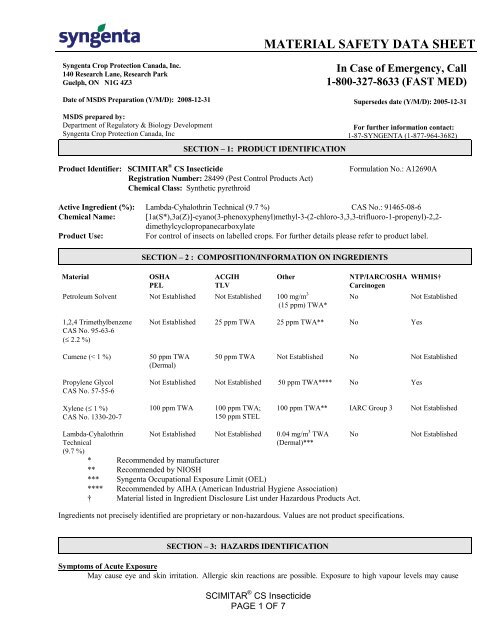
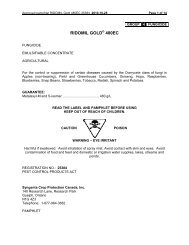
![gesagard 480sc [pamphlet] - Syngenta Crop Protection](https://img.yumpu.com/50945984/1/190x245/gesagard-480sc-pamphlet-syngenta-crop-protection.jpg?quality=85)
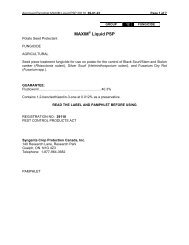
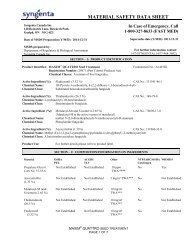
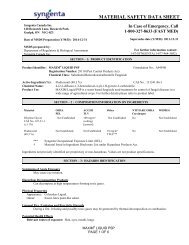
![ridomil Gold mz 68wp [bag] - Syngenta Farm](https://img.yumpu.com/49025229/1/190x245/ridomil-gold-mz-68wp-bag-syngenta-farm.jpg?quality=85)
